Facile Synthesis and Characterization of SrCO3/MgO/CaO/CaCO3 Novel Nanocomposite for Efficient Removal of Crystal Violet Dye from Aqueous Media
Abstract
:1. Introduction
2. Results and Discussion
2.1. Characterization
2.2. Adsorption of Crystal Violet Dye from Aqueous Media
2.2.1. Effect of pH
2.2.2. Effect of Contact Time
2.2.3. Effect of Temperature
2.2.4. Effect of Concentration
2.2.5. Effect of Desorption and Reusability
3. Experimental
3.1. Materials
3.2. Synthesis of SrCO3/MgO/CaO/CaCO3 Nanocomposites
3.3. Instrumentation
3.4. Adsorption Procedure of Crystal Violet Dye from Aqueous Solutions
3.5. Point of Zero Charge (pHPZC) of SrCO3/MgO/CaO/CaCO3 Nanocomposites
4. Conclusions
Author Contributions
Funding
Institutional Review Board Statement
Informed Consent Statement
Data Availability Statement
Acknowledgments
Conflicts of Interest
References
- Dutta, S.; Gupta, B.; Srivastava, S.K.; Gupta, A.K. Recent Advances on the Removal of Dyes from Wastewater Using Various Adsorbents: A Critical Review. Mater. Adv. 2021, 2, 4497–4531. [Google Scholar] [CrossRef]
- Badawi, A.K.; Abd Elkodous, M.; Ali, G.A.M. Recent Advances in Dye and Metal Ion Removal Using Efficient Adsorbents and Novel Nano-Based Materials: An Overview. RSC Adv. 2021, 11, 36528–36553. [Google Scholar] [CrossRef] [PubMed]
- Zheng, G.; Fu, P.; Li, X. Frontiers in Machine Learning Strategies for Dye Removal in Water Treatment. J. Water Process Eng. 2025, 71, 107251. [Google Scholar] [CrossRef]
- Firmansyah, M.L.; Ashraf, M.; Ullah, N. A Critical Review on the Removal of Anionic Dyes by Cross-Linked Resin: Recent Progress, Challenges and Future Perspective. Sep. Purif. Technol. 2025, 360, 131111. [Google Scholar] [CrossRef]
- Ahmad, S.; Mujtaba, G.; Zubair, M.; Shah, M.U.H.; Daud, M.; Mu’azu, N.D.; Al-Harthi, M.A. A Review of Performance, Mechanism, and Challenges of Layered Double Hydroxide-Based Biocomposites for the Adsorptive Removal of Dye Contaminants from Water and Wastewater. J. Water Process Eng. 2025, 70, 106837. [Google Scholar] [CrossRef]
- Silina, A.; El Achari, A.; Salaün, F. Metal-Organic Framework Electrospun Nanofibers in Application to Dye Removal from Textile Wastewaters: A Review. J. Environ. Chem. Eng. 2024, 12, 114819. [Google Scholar] [CrossRef]
- Osugi, M.E.; Rajeshwar, K.; Ferraz, E.R.A.; de Oliveira, D.P.; Araújo, Â.R.; Zanoni, M.V.B. Comparison of Oxidation Efficiency of Disperse Dyes by Chemical and Photoelectrocatalytic Chlorination and Removal of Mutagenic Activity. Electrochim. Acta 2009, 54, 2086–2093. [Google Scholar] [CrossRef]
- Park, D.; Nam, S.N.; Jung, B.; Soo Choi, J.; Min Park, C.; Earn Choong, C.; Jang, M.; Cho, K.S.; Jun, B.M.; Yoon, Y. Removal of Selected Contaminants of Dyes and Pharmaceuticals Using MXene-Based Nanoadsorbents: A Review. Sep. Purif. Technol. 2024, 341, 126864. [Google Scholar] [CrossRef]
- Radia, N.D.; Aljeboree, A.M.; Mhammed, A.A.A. Enhanced Removal of Crystal Violet from Aqueous Solution Using Carrageenan Hydrogel Nanocomposite/MWCNTs. Inorg. Chem. Commun. 2024, 167, 112803. [Google Scholar] [CrossRef]
- Brandão, A.T.S.C.; Rosoiu-State, S.; Costa, R.; Enache, L.B.; Mihai, G.V.; Vázquez, J.A.; Valcarcel, J.; Anicai, L.; Enachescu, M.; Pereira, C.M. Unlocking the Power of Amorphous TiO2-Decorated Biocarbon Composite: Enhanced Photocatalytic Performance for Crystal Violet Dye Degradation. J. Water Process Eng. 2025, 71, 107288. [Google Scholar] [CrossRef]
- Li, Y.; Shi, Z.; Zhang, X.; Guo, J.; Yang, Z.; Liu, X.; Han, L. Magnetic Chitosan-Functionalized Bone Char for Efficient Removal of Anionic Dyes: Insights into Adsorption-Enhanced Mechanism. Int. J. Biol. Macromol. 2025, 305, 140941. [Google Scholar] [CrossRef]
- Kishore, K.; Kaur, J.; Saddeek, Y.B.; Sharma, M.; Singh, M.; Thakur, P.; Walia, Y.K.; Lal, M.; Suman, R.; Reddy, A.S.; et al. Efficient Removal of Toxic Dyes from Water Using Mn3O4 Nanoparticles: Synthesis, Characterization, and Adsorption Mechanisms. J. Mol. Struct. 2025, 1333, 141756. [Google Scholar] [CrossRef]
- Muniasamy, S.K.; Alobaid, A.A.; Warad, I.; Ravindiran, G. Removal of Brilliant Green Dye in Aqueous Solution Using Synthetic Coagulation and Flocculation Technique. Desalination Water Treat. 2023, 314, 231–240. [Google Scholar] [CrossRef]
- Ihaddaden, S.; Aberkane, D.; Boukerroui, A.; Robert, D. Removal of Methylene Blue (Basic Dye) by Coagulation-Flocculation with Biomaterials (Bentonite and Opuntia Ficus Indica). J. Water Process Eng. 2022, 49, 102952. [Google Scholar] [CrossRef]
- Fadeeva, N.P.; Volkova, I.R.; Kharchenko, I.A.; Elsuf’ev, E.V.; Fomenko, E.V.; Akimochkina, G.V.; Afanasova, K.A.; Nemtsev, I.V.; Tarasova, L.S.; Yushkin, A.A.; et al. Development of Composite Ultrafiltration Membrane from Fly Ash Microspheres and Alumina Nanofibers for Efficient Dye Removal from Aqueous Solutions. Ceram. Int. 2024, 50, 52890–52903. [Google Scholar] [CrossRef]
- Rakcho, Y.; Baidou, M.; Naboulsi, A.; Bouazizi, A.; Mouiya, M.; Sehaqui, H.; Abouliatim, Y.; Benhammou, A.; Ouammou, M.; Abourriche, A.; et al. Fabrication of Low-Cost Ceramic Nanofiltration Membrane from Natural Resources for the Removal of Cationic and Anionic Dyes: Experimental and DFT Investigations. Chem. Eng. J. 2025, 505, 159779. [Google Scholar] [CrossRef]
- Lin, T.; Wu, Y.; Chen, H.; Ren, X.; Joshi, R. Graphene Oxide-Polyvinyl Alcohol Nanofiltration Membranes for Efficient Dye Removal in Practical Conditions. J. Membr. Sci. 2025, 719, 123736. [Google Scholar] [CrossRef]
- Cui, T.; Wang, X.; Chen, Y.; Chen, Y.; Fu, B.; Tu, Y. Reverse Osmosis Coupling Multi-Catalytic Ozonation (RO-MCO) in Treating Printing and Dyeing Wastewater and Membrane Concentrate: Removal Performance and Mechanism. Water Resour. Ind. 2023, 30, 100217. [Google Scholar] [CrossRef]
- Al-Bastaki, N. Removal of Methyl Orange Dye and Na2SO4 Salt from Synthetic Waste Water Using Reverse Osmosis. Chem. Eng. Process. Process Intensif. 2004, 43, 1561–1567. [Google Scholar] [CrossRef]
- Leng, Q.; Xu, S.; Wu, X.; Wang, S.; Jin, D.; Wang, P.; Wu, D.; Dong, F. Electrochemical Removal of Synthetic Methyl Orange Dyeing Wastewater by Reverse Electrodialysis Reactor: Experiment and Mineralizing Model. Environ. Res. 2022, 214, 114064. [Google Scholar] [CrossRef]
- Jia, Y.; Wu, X.; Xu, S.; Zhang, Y.; Wang, S. Experimental Investigation on Dyeing Wastewater Treatment and By-Product Hydrogen with a Reverse Electrodialysis Flocculator. Int. J. Hydrogen Energy 2023, 48, 19022–19032. [Google Scholar] [CrossRef]
- Goswami, D.; Mukherjee, J.; Mondal, C.; Bhunia, B. Bioremediation of Azo Dye: A Review on Strategies, Toxicity Assessment, Mechanisms, Bottlenecks and Prospects. Sci. Total Environ. 2024, 954, 176426. [Google Scholar] [CrossRef] [PubMed]
- Pratap Singh, V.; Godara, P.; Srivastava, A. Sustainable Microalgal Bioremediation of Heavy Metals and Dyes from Synthetic Wastewater: Progressing towards United Nations Sustainable Development Goals. Waste Manag. Bull. 2024, 2, 123–135. [Google Scholar] [CrossRef]
- Safaralizadeh, E.; Mahjoub, A.; Janitabardarzi, S. Visible Light-Induced Degradation of Phenolic Contaminants Utilizing Nanoscale TiO2 and ZnO Impregnated with SR 7B (SR) Dye as Advanced Photocatalytic Systems. Ceram. Int. 2024, 51, 1958–1969. [Google Scholar] [CrossRef]
- Amrollahi, R. Comparison of Photocatalytic Activity of Cu/TiO2, Cu/NiO and Cu/ZnO Nanocomposites for the Degradation of Organic Dyes. Appl. Catal. O Open 2024, 195, 207010. [Google Scholar] [CrossRef]
- Mustafa, G.; Munir, R.; Sadia, B.; Younas, F.; Sayed, M.; Muneer, A.; Sardar, M.F.; Albasher, G.; Noreen, S. Synthesis of Polymeric Ferrite Composites (Ni-CoFe2O4/Chitosan, Zn-NiFe2O4/Starch, Co-NiZnFe2O4/Polyaniline, Ni Doped CrZnFe2O4/Alginate, and Cr Doped ZnCoFe2O4/PVA) for the Removal of Reactive Golden Yellow-160 Dye from Wastewater. J. Environ. Chem. Eng. 2024, 12, 112581. [Google Scholar] [CrossRef]
- Iram, M.; Guo, C.; Guan, Y.; Ishfaq, A.; Liu, H. Adsorption and Magnetic Removal of Neutral Red Dye from Aqueous Solution Using Fe3O4 Hollow Nanospheres. J. Hazard. Mater. 2010, 181, 1039–1050. [Google Scholar] [CrossRef]
- Zhang, F.; Chen, X.; Wu, F.; Ji, Y. High Adsorption Capability and Selectivity of ZnO Nanoparticles for Dye Removal. Colloids Surf. A Physicochem. Eng. Asp. 2016, 509, 474–483. [Google Scholar] [CrossRef]
- Arun Viswan, K.K.; Dixit, D.; Bhattacharya, S.; Adhikary, S.; Gangadharan, D. A Sustainable Synthesis of a CuO@C Nanocomposite for the Remediation of Organic Dyes in Water and Its Antibacterial Properties. Nano-Struct. Nano-Objects 2024, 38, 101147. [Google Scholar] [CrossRef]
- Madan, S.; Shaw, R.; Tiwari, S.; Tiwari, S.K. Adsorption Dynamics of Congo Red Dye Removal Using ZnO Functionalized High Silica Zeolitic Particles. Appl. Surf. Sci. 2019, 487, 907–917. [Google Scholar] [CrossRef]
- Aldaghri, O.; El-Badry, B.A.; Ibnaouf, K.H.; Taha, K.K.; Aissa, M.A.B.; Modwi, A. CaO@ZrO2@g-C3N4 Nanosorbent for Superior Malachite Green Dye Selectivity and Adsorption from Contaminated Water. Diam. Relat. Mater. 2024, 144, 110944. [Google Scholar] [CrossRef]
- Abdulhameed, A.S.; Khan, M.K.A.; Alshahrani, H.; Younes, M.K.; Algburi, S. Newly Developed Polymer Nanocomposite of Chitosan-Citrate/ZrO2 Nanoparticles for Safranin O Dye Adsorption: Physiochemical Properties and Response Surface Methodology. Mater. Chem. Phys. 2024, 324, 129699. [Google Scholar] [CrossRef]
- Zhang, J.L.; Wang, Z.Z.; Yang, T.Y.; Chatterjee, S.; Cao, M.S.; Peng, H.S. Facile Synthesis of Vaterite CaCO3 Microspheres from Carbon Capture and Solid Waste Utilization towards Microwave Absorption and Dye Wastewater Adsorption. Carbon N. Y. 2024, 226, 119199. [Google Scholar] [CrossRef]
- Nallasamy, P.; Al-Ansari, M.M.; Manikam, P.; Natarajan, S. Agro-Waste Derived RGO/CaCO3 Hybrid Nanostructure as Green Adsorbent for Waste Water Treatment. J. Taiwan Inst. Chem. Eng. 2025, in press. [Google Scholar] [CrossRef]
- Qin, Q.; Li, M.; Lan, P.; Liao, Y.; Sun, S.; Liu, H. Novel CaCO3/Chitin Aerogel: Synthesis and Adsorption Performance toward Congo Red in Aqueous Solutions. Int. J. Biol. Macromol. 2021, 181, 786–792. [Google Scholar] [CrossRef]
- Jawad, A.H.; Maharani, R.A.; Hapiz, A.; ALOthman, Z.A.; Wilson, L.D. A Comparison of Freeze- and Air-Dried Chitosan Salicylaldehyde/Calcium Oxide Biocomposites for Optimized Removal of Acid Red 88 Dye. Int. J. Biol. Macromol. 2025, 292, 139165. [Google Scholar] [CrossRef]
- Rani, S.; Kumar, P.; Kataria, N. Development of Chemically and Green Synthesized MgO Nanoparticles for CR and BG Dye Adsorption from Single and Binary Aqueous System. J. Taiwan Inst. Chem. Eng. 2024, 166, 105566. [Google Scholar] [CrossRef]
- Al-kadhi, N.S.; Abdelrahman, E.A.; Alamro, F.S.; Saad, F.A.; Al-Raimi, D.S. Innovative nanocomposite comprising of ZrO2, MnCO3, and CdCO3 for superior crystal violet dye adsorption: Synthesis, characterization, and regeneration insights. Sci. Rep. 2025, 15, 5525. [Google Scholar] [CrossRef]
- Muthukumaran, C.; Sivakumar, V.M.; Thirumarimurugan, M. Adsorption Isotherms and Kinetic Studies of Crystal Violet Dye Removal from Aqueous Solution Using Surfactant Modified Magnetic Nanoadsorbent. J. Taiwan Inst. Chem. Eng. 2016, 63, 354–362. [Google Scholar] [CrossRef]
- Ahamad, Z.; Nasar, A. Polypyrrole-Decorated Bentonite Magnetic Nanocomposite: A Green Approach for Adsorption of Anionic Methyl Orange and Cationic Crystal Violet Dyes from Contaminated Water. Environ. Res. 2024, 247, 118193. [Google Scholar] [CrossRef]
- Khan, T.A.; Khan, E.A.; Shahjahan. Removal of Basic Dyes from Aqueous Solution by Adsorption onto Binary Iron-Manganese Oxide Coated Kaolinite: Non-Linear Isotherm and Kinetics Modeling. Appl. Clay Sci. 2015, 107, 70–77. [Google Scholar] [CrossRef]
- Marica, I.; Nekvapil, F.; Ștefan, M.; Farcău, C.; Falamaș, A. Zinc Oxide Nanostructures for Fluorescence and Raman Signal Enhancement: A Review. Beilstein J. Nanotechnol. 2022, 13, 472–490. [Google Scholar] [CrossRef] [PubMed]
- Liu, X.; Wang, Y.; Wu, X.; Wang, Y.; Fan, G.; Huang, Y.; Zhang, L. Preparation of Magnetic DTPA-Modified Chitosan Composite Microspheres for Enhanced Adsorption of Pb(II) from Aqueous Solution. Int. J. Biol. Macromol. 2024, 264, 130410. [Google Scholar] [CrossRef]
- Jiang, R.; Shen, T.T.; Zhu, H.Y.; Fu, Y.Q.; Jiang, S.T.; Li, J.B.; Wang, J.L. Magnetic Fe3O4 Embedded Chitosan–Crosslinked-Polyacrylamide Composites with Enhanced Removal of Food Dye: Characterization, Adsorption and Mechanism. Int. J. Biol. Macromol. 2023, 227, 1234–1244. [Google Scholar] [CrossRef]
- Ehab, N.S.A.; Fowzia, A.A.; Fawaz, S.A.; Doaa, A.S. Facile Synthesis of MnCO3/ZrO2/MgCO3 Nanocomposite for High-Efficiency Malachite Green Dye Removal. J. Inorg. Organomet. Polym. Mater. 2025; in press. [Google Scholar] [CrossRef]
- Xinyu, Z.; Tao, F.; Hongwei, Y.; Ming, G.; Nuraje, N. Preparation of Chitosan-like Magnetic Composite Microspheres and Their Adsorption Properties for Cu (II). Mater. Today Proc. 2022, 71, 105–113. [Google Scholar] [CrossRef]
- Tang, L.; Liu, C.; Liu, X.; Zhang, L.; Fan, B.; Wang, B.; Wang, F. Efficient Adsorption of Crystal Violet by Different Temperature Pyrolyzed Biochar-Based Sodium Alginate Microspheres: A Green Solution for Food Industry Dye Removal. Food Chem. X 2025, 26, 102311. [Google Scholar] [CrossRef]
- Azari, A.; Noorisepehr, M.; Dehganifard, E.; Karimyan, K.; Hashemi, S.Y.; Kalhori, E.M.; Norouzi, R.; Agarwal, S.; Gupta, V.K. Experimental Design, Modeling and Mechanism of Cationic Dyes Biosorption on to Magnetic Chitosan-Lutaraldehyde Composite. Int. J. Biol. Macromol. 2019, 131, 633–645. [Google Scholar] [CrossRef]
- Gupta, S.; Prajapati, A.; Kumar, A.; Acharya, S. Synthesis of Silica Aerogel and Its Application for Removal of Crystal Violet Dye by Adsorption. Watershed Ecol. Environ. 2023, 5, 241–254. [Google Scholar] [CrossRef]

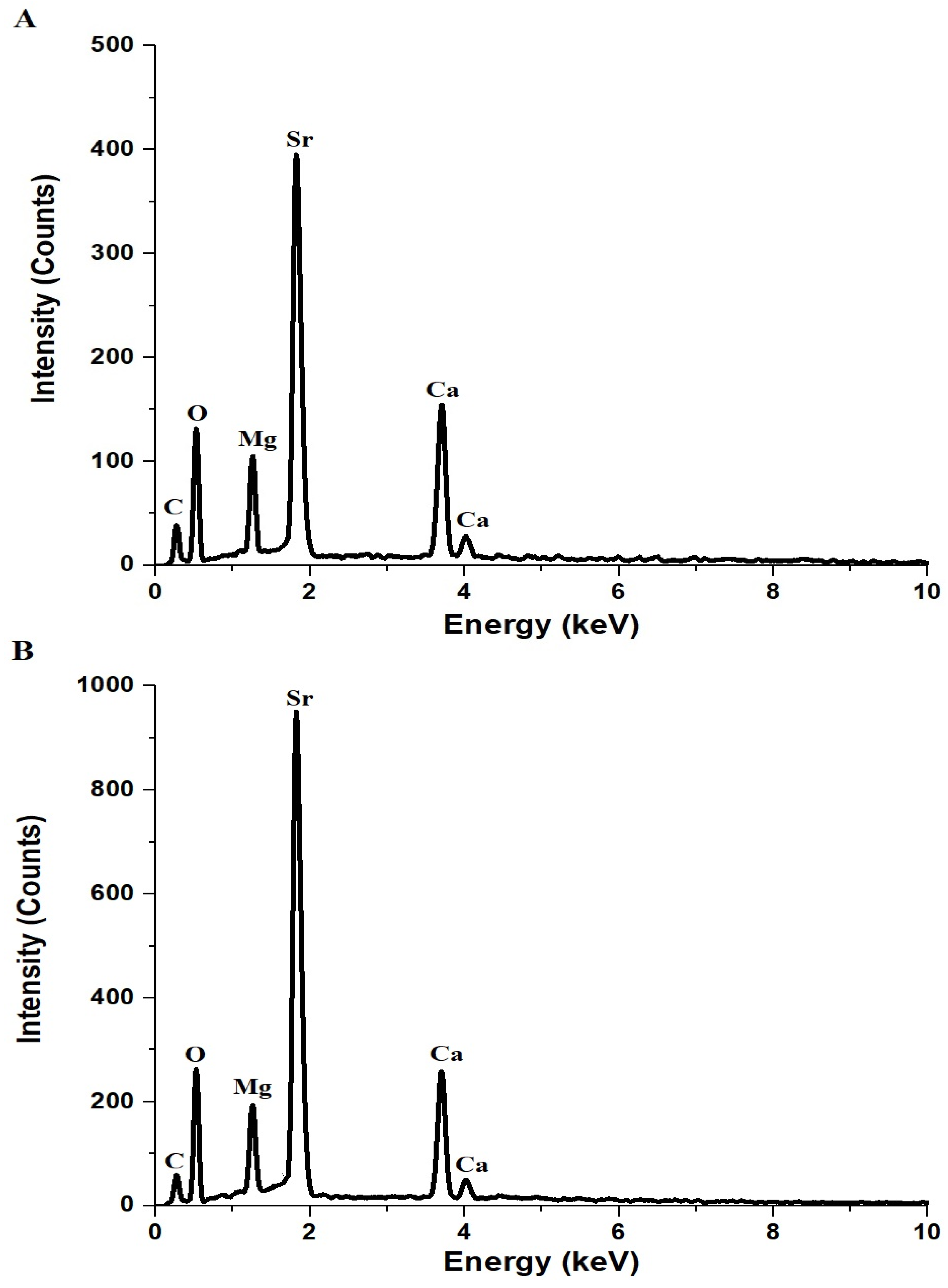
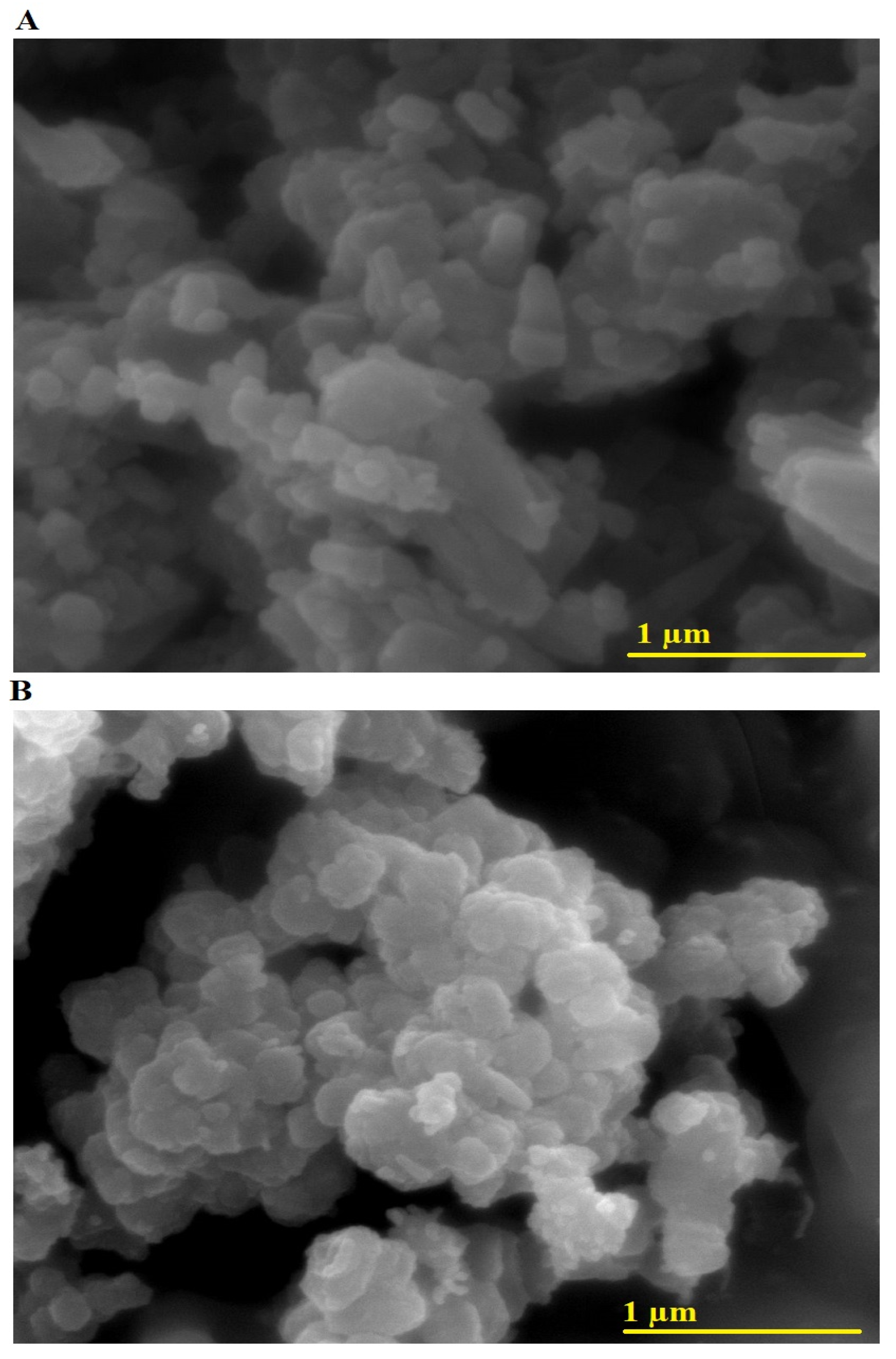



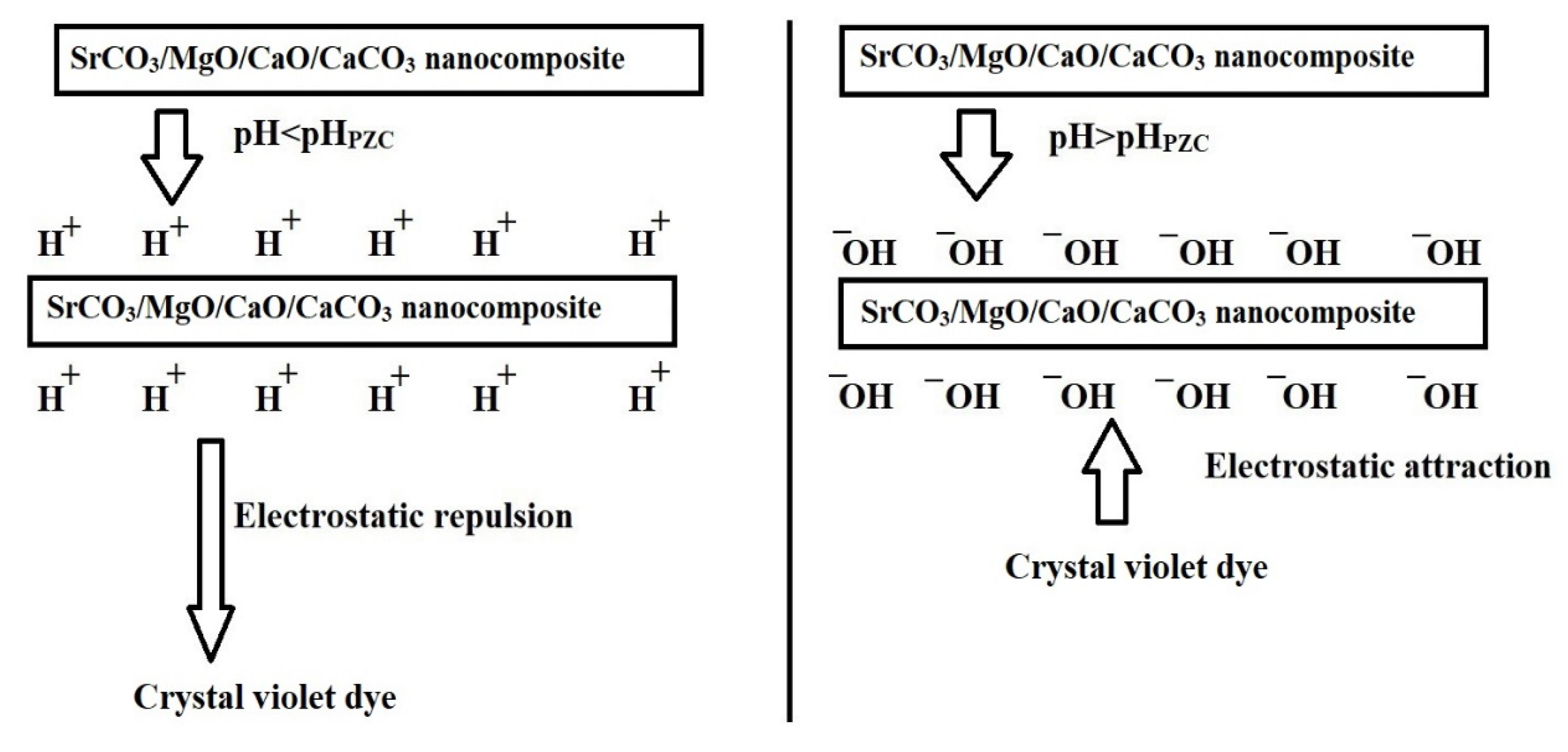

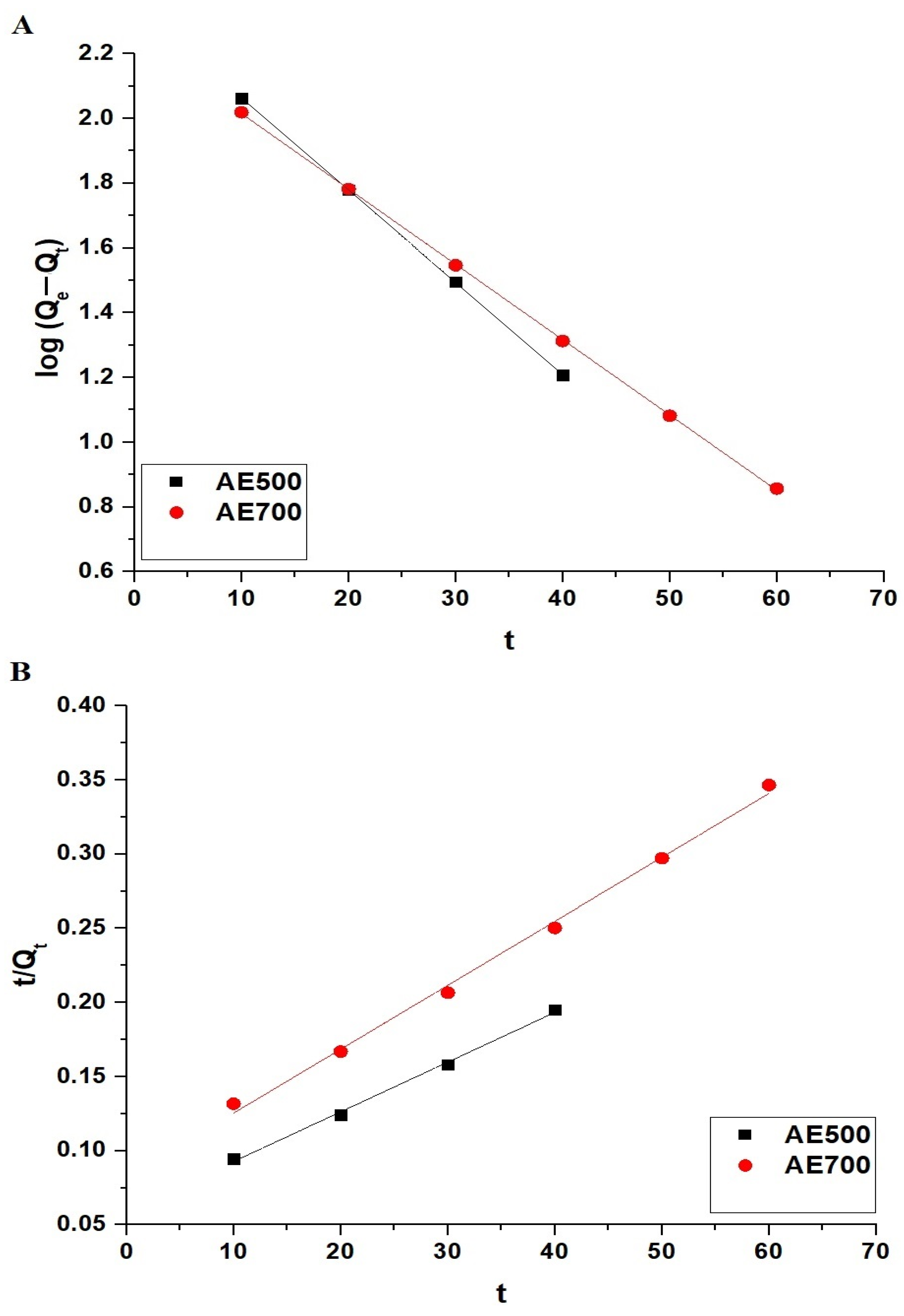
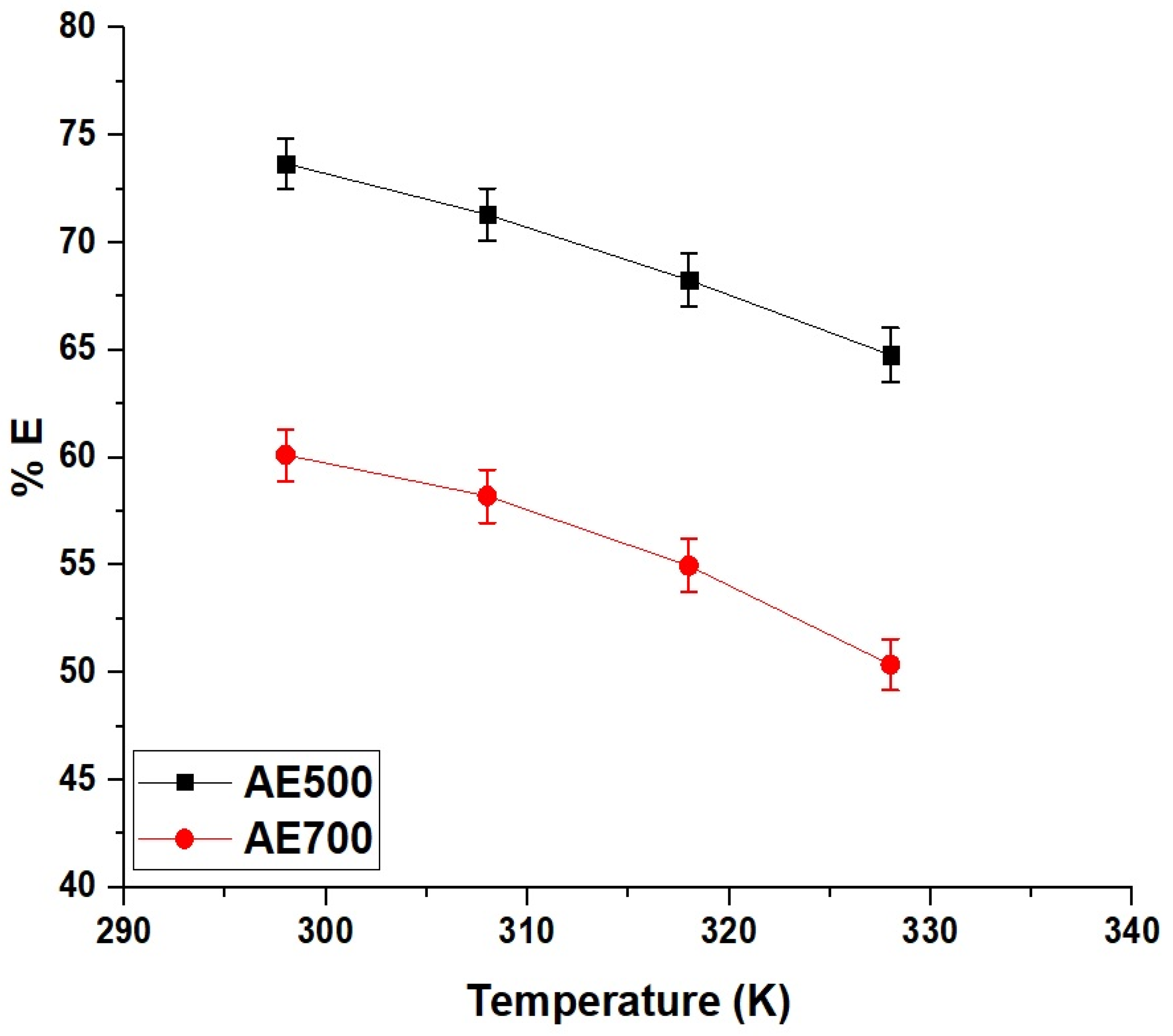


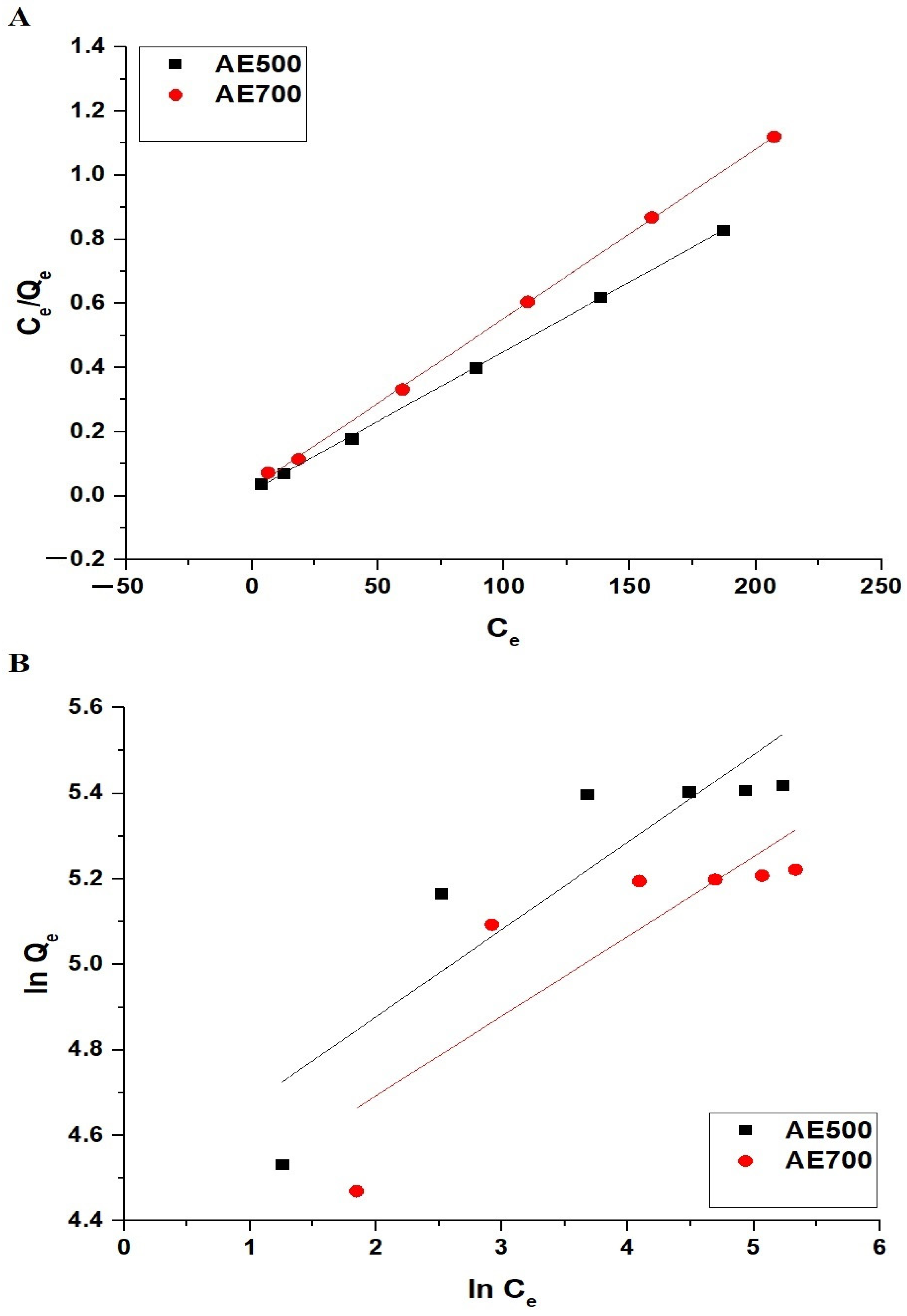



| Sample | Atomic Percentages | ||||
|---|---|---|---|---|---|
| % C | % O | % Mg | % Ca | % Sr | |
| AE500 | 19.1 | 55.8 | 5.1 | 8.6 | 11.4 |
| AE700 | 16.7 | 56.8 | 4.8 | 7.4 | 14.3 |
| Sample | QExp (mg/g) | Pseudo-First-Order | Pseudo-Second-Order | ||||
|---|---|---|---|---|---|---|---|
| K1 (1/min) | R2 | Qe (mg/g) | K2 (g/mg.min) | R2 | Qe (mg/g) | ||
| AE500 | 221.04 | 0.0656 | 0.9999 | 222.97 | 0.000146 | 0.9963 | 298.51 |
| AE700 | 180.36 | 0.0536 | 0.9999 | 176.74 | 0.000226 | 0.9955 | 232.02 |
| Sample | ΔS° (kJ/mol·K) | ΔH° (kJ/mol) | ΔG° (kJ/mol) | |||
|---|---|---|---|---|---|---|
| 298 | 308 | 318 | 328 | |||
| AE500 | 0.0239 | −11.46 | −18.59 | −18.83 | −19.07 | −19.31 |
| AE700 | 0.0265 | −10.72 | −18.62 | −18.89 | −19.15 | −19.42 |
| Sample | Langmuir | Freundlich | |||||
|---|---|---|---|---|---|---|---|
| Qmax (mg/g) | R2 | K3 (L/mg) | K4 (mg/g)(L/mg)1/n | Qmax (mg/g) | 1/n | R2 | |
| AE500 | 230.41 | 0.9997 | 0.2718 | 87.27 | 257.62 | 0.2043 | 0.7533 |
| AE700 | 189.39 | 0.9994 | 0.2104 | 75.22 | 201.90 | 0.1864 | 0.6716 |
| Adsorbent | Qmax (mg/g) | Ref. |
|---|---|---|
| Surfactant-modified magnetic nanoadsorbent | 166.67 | [39] |
| Biochar-based sodium alginate microspheres | 223.88 | [47] |
| Polypyrrole-decorated bentonite magnetic nanocomposite | 78.74 | [40] |
| Iron–manganese oxide coated kaolinite | 19.75 | [41] |
| Magnetic chitosan–glutaraldehyde composite | 102.08 | [48] |
| Silica aerogel | 137.17 | [49] |
| AE500 | 230.41 | This study |
| AE700 | 189.39 | This study |
| Effect | V (L) | Co (mg/L) | W (mg) | T (K) | t (min) | pH |
|---|---|---|---|---|---|---|
| pH | 0.1 | 150 | 50 | 298 | 240 | 2–10 |
| Time | 0.1 | 150 | 50 | 298 | 10–100 | 10 |
| Temperature | 0.1 | 150 | 50 | 298–328 | 50 (AE500) 70 (AE700) | 10 |
| Concentration of crystal violet dye | 0.1 | 50–300 | 50 | 298 | 50 (AE500) 70 (AE700) | 10 |
Disclaimer/Publisher’s Note: The statements, opinions and data contained in all publications are solely those of the individual author(s) and contributor(s) and not of MDPI and/or the editor(s). MDPI and/or the editor(s) disclaim responsibility for any injury to people or property resulting from any ideas, methods, instructions or products referred to in the content. |
© 2025 by the authors. Licensee MDPI, Basel, Switzerland. This article is an open access article distributed under the terms and conditions of the Creative Commons Attribution (CC BY) license (https://creativecommons.org/licenses/by/4.0/).
Share and Cite
Abdelrahman, E.A.; Basha, M.T. Facile Synthesis and Characterization of SrCO3/MgO/CaO/CaCO3 Novel Nanocomposite for Efficient Removal of Crystal Violet Dye from Aqueous Media. Inorganics 2025, 13, 112. https://doi.org/10.3390/inorganics13040112
Abdelrahman EA, Basha MT. Facile Synthesis and Characterization of SrCO3/MgO/CaO/CaCO3 Novel Nanocomposite for Efficient Removal of Crystal Violet Dye from Aqueous Media. Inorganics. 2025; 13(4):112. https://doi.org/10.3390/inorganics13040112
Chicago/Turabian StyleAbdelrahman, Ehab A., and Maram T. Basha. 2025. "Facile Synthesis and Characterization of SrCO3/MgO/CaO/CaCO3 Novel Nanocomposite for Efficient Removal of Crystal Violet Dye from Aqueous Media" Inorganics 13, no. 4: 112. https://doi.org/10.3390/inorganics13040112
APA StyleAbdelrahman, E. A., & Basha, M. T. (2025). Facile Synthesis and Characterization of SrCO3/MgO/CaO/CaCO3 Novel Nanocomposite for Efficient Removal of Crystal Violet Dye from Aqueous Media. Inorganics, 13(4), 112. https://doi.org/10.3390/inorganics13040112







